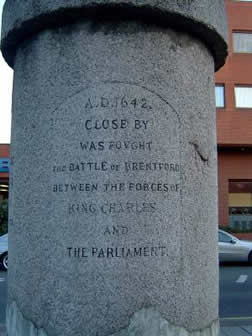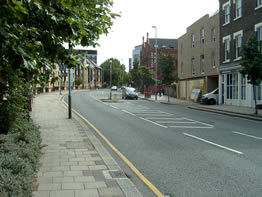Battle of Brentford 1642
The raising of the Royal Standard on 22 August 1642 signalled the formal beginning of the Civil War. On 12 October the king’s army left Shrewsbury to try to get ahead of the parliamentarian army under the Earl of Essex on a march on London, but was forced to offer battle at Edgehill in Warwickshire on 23 October. Following the battle Essex left the field to the king and subsequently retreated back to London via Northampton arriving in the capital on 7 November. The royalists meanwhile occupied Banbury, Oxford and Reading as they advanced slowly on London. By 10 November with the royal army was deployed in a wide area to the west of London and parliament voted to open peace negotiations with the king. Meeting parliament’s representatives at Colnbrook on 11 November, the king agreed to talks at Windsor.
But before the meeting, the royalists had already decided to re-supply their troops with ammunition ready to march toward London the next day. During the morning of 12 November the royal army assembled on Hounslow Heath expecting to encounter parliamentary forces. Finding none, Prince Rupert, the king’s nephew who commanded the royalist cavalry, intended to lead the army in the assault on parliamentary troops in Brentford which were blocking the Great West Road – the chosen route into London, but General Patrick Ruthven, the Earl of Forth, who would be made Earl of Brentford in 1644, came up and took overall control of royalist forces.

The monument to the battle in Brentford
Whilst all the royal army, which probably totalled around 13,000 men, appears to have advanced to Hounslow, not all was engaged at Brentford. Up to 4,000 royalist foot and 800 cavalry were engaged at Brentford and they were supported by four cannons. For parliament, Brentford was defended by the foot regiments of Denzil Holles and Lord Brooke consisting of around 700-800 men and 480 men respectively. These soldiers were supported by 10-12 troops of cavalry, but most of these fled on hearing the royalist attack
The royalists reached Brentford around midday in heavy mist, advancing down the London Road and along Syon Lane from Isleworth. To the west of Brentford on the London Road, Sir Richard Wynn’s house was held for parliament by soldiers from Denzil Holles’ red coated regiment. When the leading royalist cavalry belonging to the Prince of Wales’ regiment neared the house, they were surprised by parliamentary artillery positioned behind a great hedge and forced to retreat until Sir Thomas Salisbury’s royalist foot regiment arrived to press the attack.
The parliamentary pickets at Sir Richard Wynn's House were cleared by Salisbury’s regiment and the royalists advanced to find the entrance to Brentford blocked by a small barricade, probably at the bridge across the River Brent. A further royalist attack by 1,000 musketeers dislodged the parliamentary troops there in under one hour and forced them to retreat to another defensive barricade, probably located on the crest of the rising ground near the modern day Ferry Lane. This was defended by Lord Brooke’s purple coated regiment of foot and two small pieces of artillery. The royalists seem to have had some difficulty in overcoming this obstacle, assaulting it with six regiments of foot and being forced to outflank the position to make it untenable.

The position of the second parliamentary barricade on top of the rising ground.
After between two and three hours fighting, parliamentary troops were driven from this position. Some routed through Brentford toward London but others tried to escape by swimming the Thames. Scores drowned. The royalists continued their advance through Brentford only to encounter fresh parliamentary troops in an open field outside the town, probably Turnham Green or Chiswick common field. These were the green coats of John Hampden’s regiment of foot which charged the royalists five times in order to cover the retreat of what remained of Holles’s and Brooke’s regiments. By now it was late afternoon and, with the light fading and royalist forces exhausted from over four hours of combat, the opposing forces disengaged. Brentford was subsequently looted by the victorious royalist soldiers.
Parliament's forces suffered in the action. Around 50 parliamentarian soldiers were killed in the fighting and more again probably drowned. Twenty-one officers and 306 soldiers (57 from Brooke’s and 249 from Holles’) regiments were captured. Royalist losses are poorly recorded and probably numbered around twenty.
Overnight following the battle, parliament tried to bring arms and ammunition down the Thames from Kingston by barge to help defend the City. The barges came under musket fire from Syon House injuring crew members. But between Brentford and the modern day Kew Bridge the royalists had deployed cannon covering the river and, judging they had little chance of escaping this threat, the parliamentarian sailors scuttled their vessels. Separately on the afternoon of 13 November two parliamentary vessels on the Thames attacked Syon House with cannon, damaging the house. Royalist counter-fire appears to have sunk one of the vessels.
The battle at Brentford had checked the king’s advance on the capital and had lost him the element of surprise. Nevertheless, the objective of capturing Brentford had been achieved and all now rested on the outcome of 13 November. If the king could either push on without meeting serious opposition, or defeat any of parliament’s forces which he encountered, he would be in a strong position to dictate the terms of a settlement, with the prospect that the war would be over by Christmas.

